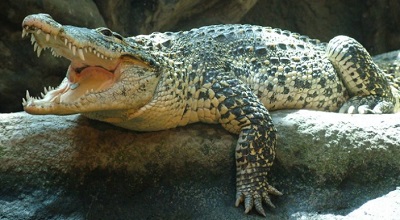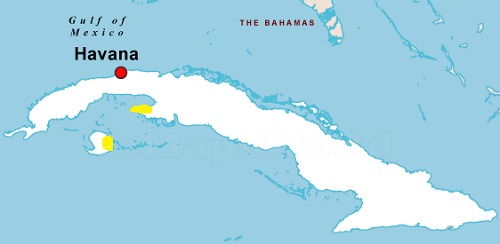Taxonomy
Family |
Phylum |
Class |
Order |
Family |
Genus |
Species |
| Animalia | Chordata | Reptilia | Crocodylia | Crocodylidae | Crocodylus | Crocodylus rhombifer |
.
Cuban crocodile in Hoyerswerda Zoo in Saxony, Germany
Name
- Scientific name: Crocodylus rhombifer
- Common name: Cuban crocodile
Physical Features
- The Cuban crocodile have powerful legs that give them the ability to jump. They are able to leap from the water and snatch animals hanging from branches.
- These crocodiles have short and broad head, broad snout with slight nasal prominences.
- It is a distinctive crocodile species. Its body is covered in yellow, olive green and black pebbled scales which are rougher than other crocodiles.
- Bony plates or squamosals are found behind the eyes on top of the head of the Cuban crocodiles and is more pronounced than in other species.
- Their feet have less webbing than other species which help them walk on land.
- Hybrids exhibit characteristics of both species.
Distribution and Habitat
- Over the years its range has been narrowed. Today the habitat of Cuban crocodiles is restricted to the Zapata Swamp in the great peninsula in Cuba and in Isla de la Juventud in Lanier Swamp. Lanier Swamp is located in the great peninsula on the south central coast of Cuba.
- They have the smallest distribution of any other crocodile in the world.
- Cuban crocodiles live in fresh water marshes, sawgrass swamps, lagoons, canals, rivers and water pockets.
- Scientists estimate that there are 5,000 remaining Cuban crocodiles in the wild.
Size and Weight
- The Cuban crocodile is a medium size crocodilian. Its average length is 11 feet or 3.5 meters and its average weight is 474 pounds or 215 kilograms. Crocodiles measuring up to 14.76 feet or 4.5 meters have been reported.
Behavior
- The Cuban crocodile is the most terrestrial of all crocodile species.
- It is also the most aggressive species.
- They are very territorial and defensive.
- They hunt by swimming with their eyes and nostrils above the surface then surprise their prey by dragging it under the water. If the prey is small they will swallow it whole or tear it into pieces and then swallow.
Diet
- The Cuban crocodile preys on small mammals, especially hutias and freshwater turtles, they also eat fish and crustaceans.
Reproduction
- Cuban crocodiles reach reproductive age at 6 years old.
- Reproduction is affected by environmental conditions such as temperature and rainfall.
- They mate between May and July when the water levels are at its lowest.
- They nest during the rainy season.
- Cuban crocodiles have been observed constructing their nest by building a mound. Once the eggs are laid the female guards the nest from predators. Eggs are about 3 inches long.
- Clutch size is on average 25 eggs in captivity and 14 eggs in the wild.
- Eggs hatch in August to early September.
Life Expectancy
- Their life span is over 50 years in captivity.
Threats
- During the 19th century until the 1960s these crocodiles were hunted to almost extinction. Today poaching and habitat destruction are one their biggest threats.
- Interbreeding with American crocodiles (Crocoyilus acuctus) is driving the species to the risk of extinction. Its genetics will mix and eventually get replaced.
Conservation Status
Did you know?
Crocodile farms have been established to satisfy the need for skin and meat.
References and further research
IUCN List of Threatened Species
Smithsonian National Zoological Park
Crocodiles of the World – Crocodile Conservation and Education Centre


